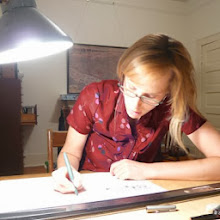Perhaps students takes these moments for granted. I suppose I did, on occasion. The opportunity to just sit in semi-darkness and Think - not aimlessly, but about one's own ambitions, wonderings, inklings guided by the words and images of, in this case, quite a brilliant voice. To Think, to Record, and ideally, to Act on the Ideas that emerged during the Lecture. It was so indulgent, I thought.
These are some points that stuck and the images Michael Kimmelman's words and images conjured in my mind. (None of these are direct quotes nor images from Kimmelman; rather, they are the ideas conjured in my mind by his words.)
Cartier-Bresson draws at the Louvre (and lives across the street.) He shot photographs in the streets.
 (I ran through the Louvre so I could take on the streets and the quays...Guilty.)
(I ran through the Louvre so I could take on the streets and the quays...Guilty.)
Kimmelman's college friend, Alex, a young writer lived in a small New York apartment lined with bookshelves filled with books to the max. When one book was acquired, another was thrown away. Alex's LIBRARY became his SELF-PORTRAIT. When Alex died young, his father moved the entire library in aspic to his own apartment in London. (Self-Portrait of a City...)
(Self-Portrait of a City...)
The digital camera robs us of the possibility of mistakes, or accidental masterpieces, such as with double exposures. (Accident in my darkroom: Ponte Vecchio, Firenze)
(Accident in my darkroom: Ponte Vecchio, Firenze)
Wunderkammer: cabinets of curiosities







 The artist finds beauty in ordinary objects and puts them under glass.
The artist finds beauty in ordinary objects and puts them under glass.
Children notice and find delight in ordinary things because they take the time to see them. This is also the task of the artist. The artist is, therefore, somewhat like a child. (Beauty in the Everyday: A stranger in Paris asked me to take his photo because he was beautiful.)
(Beauty in the Everyday: A stranger in Paris asked me to take his photo because he was beautiful.)
Regarding the recent earthquakes in L'Aquila Italy, Kimmelman recalled a similar scene following the Umbrian earthquakes in 1998. (I was in Assissi not long after these earthquakes and witnessed the old stone chapels and cathedrals of Assissi in scaffolding. Then, it was a shock to see these iconic buildings as old as the earth were not static and were even capable of being destroyed.) Kimmelman spoke of his travel to the even smaller villages near L'Aquila whose chapels and frescoes were damaged. He was moved by the spirit of patriotism for the local village artist who was the creator of the frescoes; a spirit stronger than being Italian was this provincial pride in the Art of one's own village.

Now - to Think, Record, and Act...











No comments:
Post a Comment